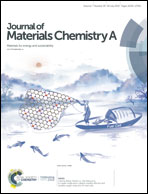Interfacial engineering of gallium indium phosphide photoelectrodes for hydrogen evolution with precious metal and non-precious metal based catalysts†
Abstract
Gallium indium phosphide (GaInP2) is a semiconductor with promising optical and electronic properties to serve as the large bandgap, top junction in a dual absorber tandem solar water splitting device. Poor intrinsic catalytic ability and surface corrosion in aqueous electrolyte remain key obstacles. Significant progress has been made developing thin-film protection layers and active catalysts for photoelectrochemical devices, but combining these into a catalytic protection layer that can provide long-term stability without sacrificing performance has proven difficult due, in large part, to challenges in developing active and stable interfaces. In this work, we demonstrate that a nanoscale molybdenum disulfide (MoS2) film functions both as an effective protection layer and excellent hydrogen evolution catalyst for GaInP2 photocathodes, with only a ∼10% loss in initial light-limited current density after 100 h, and a photocurrent onset potential better than that of the same state-of-the-art device with a platinum–ruthenium catalyst. Using transient photoreflectance spectroscopy, we probed the carrier dynamics of these photocathodes and show that the MoS2 coated device exhibits improved electron transfer at the surface interface compared to the PtRu catalyzed device. These MoS2 protected devices are among the most active and stable single-absorber photocathodes for solar water splitting to date and offer a promising pathway towards generating hydrogen with high efficiency and significant longevity.



 Please wait while we load your content...
Please wait while we load your content...
